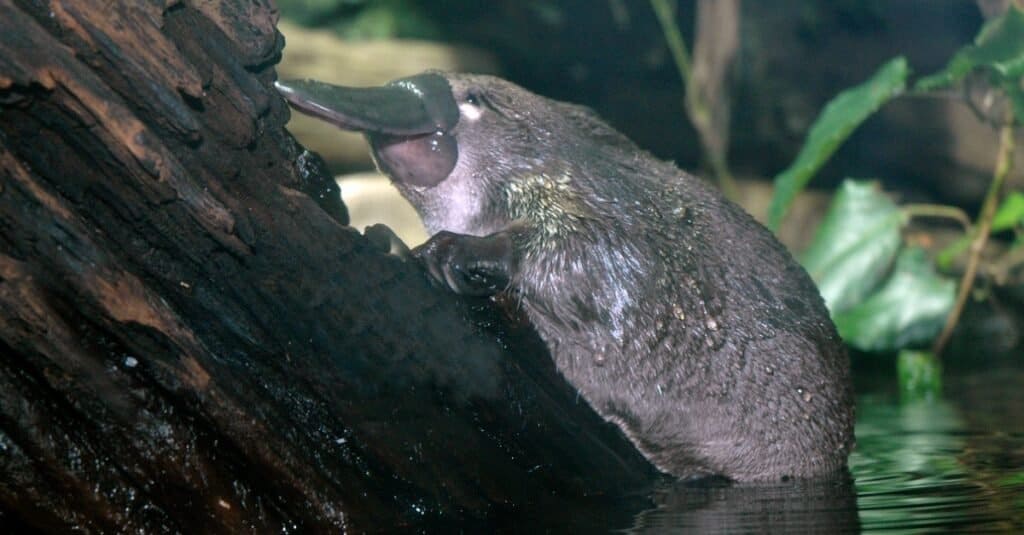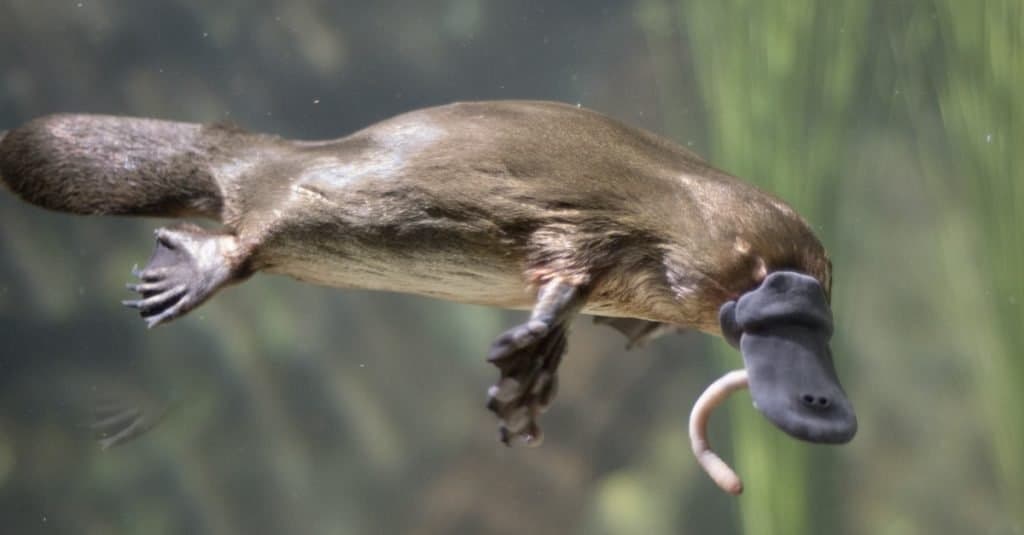Are Platypuses Poisonous or Dangerous?
@media (min-width: 481px) {
.mobile-top-content {
display: none;
}
}
#mobileTopContentCTACarouselControls { overflow: hidden; text-overflow: ellipsis; white-space: nowrap; }
.mobile-top-content .more { color: #fff; }
.mobile-top-content a { color: #fff; text-decoration: underline; }
.mobile-top-content a:hover { color: #fff; text-decoration: underline; }
@media (max-width: 480px) {
.mobile-top-content {
background-color: #06a10b;
color: #fff;
text-align: center;
/*height: 60px;
padding-top:5px;*/
font-size:80%;
/* display: block; */
margin: 0px -30px;
}
}
Platypuses may be one of the cutest and oddest animals on Earth. As babies, they look like furry little ducks with tails. But did you know that platypuses contain venom? This venom is not lethal to humans, so they are not entirely poisonous or dangerous. However, platypus venom can be so strong it can kill other mammals, such as dogs and cats!
There is no doubt that the platypus is a very interesting animal. Looking at its physical appearance alone, you wouldn’t easily figure out what a platypus is – a mammal, a bird, or a reptile? The platypus sports a mammalian body covered with fur, webbed feet like an otter, a duck’s bill, and a beaver’s tail. It even lays eggs like reptiles and lacks a stomach! But what’s more interesting is that platypuses are one of the very few mammals that possess venom.
Do Platypuses Bite?

iStock.com/Michel VIARD
Since platypuses do not have a typical mouth designed like mammals, they also do not have teeth. They have a duck-like bill that helps them scoop up and smash their food. Since they do not have teeth, platypuses cannot bite. However, male platypuses have sharp, pointed spurs at the heel of one of their hind feet. These spurs connect to a gland that holds and secretes venom. Spurs act like stingers to prick adversaries, predators, hunters, and humans. Thus, unlike other animals and mammals, platypuses do not deliver venom through their bite but through these spurs in their feet.
Platypuses may be weird in their ways, but they still have a few natural predators in the wild, including snakes, eels, and foxes. Their spur and ability to secrete venom help them get away from or deter their hunters. Besides, male platypuses also use their spurs to challenge or compete with other male platypuses, especially during the mating season. The platypus‘ venom sacks grow and secrete more venom during the spring, wherein platypus couples mate. Yet, the spurs and venom are not intended to kill other male platypus but only to aid them in the fight.
Are Platypuses Dangerous to Humans?

John Carnemolla/Shutterstock.com
The platypus venom is known to cause extreme swelling and intense pain, but they are often not dangerous or life-threatening to humans. Yet, they can be dangerous to other animals, especially smaller mammals. Since the platypus’ spur has a pointed end, the platypus sting feels like a slight pinprick. The spurs are filled with venom, causing pain on the pricked wound. The platypus venom is not strong enough to kill a human, and there has been no record of human fatalities brought by platypus venom yet. However, the spur prick can cause swelling and excruciating pain that may last for days or even weeks.
People with weaker immune systems can develop more severe symptoms that include increased sensitivity to pain or hyperalgesia, nausea, cold sweats, low blood oxygen, hyperventilation, and convulsions, depending on the amount of venom released by the platypus into the body.
The platypus venom has some molecules that are also present in reptiles. Along with solenodons, shrews, and vampire bats, the platypus is one of the few venomous mammals, as venoms are often defense mechanisms found in reptiles and arachnids. While a platypus sting can only cause severe pain in humans, its venom has a lasting and even deadly effect on other animals. Platypus males can deliver a sting that may leave animal victims incapacitated for weeks. There have not been enough studies about the composition of the platypus venom that triggers physical symptoms in humans and fatalities in animals.
Are Platypuses Poisonous to Humans?

Martin Pelanek/Shutterstock.com
Platypuses may have venom secreted through their pointed spurs, but their sting and venoms are not strong enough to poison humans or cause further damage. Some Aboriginal groups in their home country, Australia, hunt platypuses for food. However, platypuses are protected worldwide, and eating one is highly illegal. Apart from the legal notions, most people refrain from consuming platypus meat as their venom might contain toxins not good for the body.
Interestingly, platypus venom is discovered to potentially treat type II diabetes or non-insulin-dependent diabetes mellitus (NIDDM). An Australian study showed that a metabolic hormone in the platypus’ venom and digestive tract could cure type II diabetes. The metabolic hormone called glucagon-like peptide-1 helps lower blood sugar and is more resistant to enzyme degradation.
Are All Platypuses Poisonous?
Though the platypus has been dubbed “cute but vicious,” not all platypuses possess venom. Only male platypuses possess venom as they use it to fight other males during the mating season. This is also why platypuses have more venom during coupling seasons. Female platypuses have no venom but are born with stinger spurs in their hind legs. As the female platypus reaches adulthood, this spur falls off, and its ability to sting and deliver venom fades with it.
Are Platypuses Dangerous to Dogs?
Platypuses are mammals with venom not lethal to humans. However, this venom is enough to cause grave damage to pet dogs and cats and can even kill them. Taking a platypus in as a pet might not be a good idea, especially when you live with other pets in your home.
The platypus venom is excruciatingly painful for dogs and cats and cannot be alleviated by painkillers or morphine. Unlucky dogs or cats stung by platypus, unfortunately, die from the effect of their venom.
How to Avoid Platypus Stings?
Platypuses do not attack humans. They are not equipped with teeth that can help them bite, and the only form of defense they have is the pointed spur in their heel. However, if platypuses are handled in the wild, they can prick you with their spur and inject venom. The best way to avoid a platypus sting is to refrain from holding them in the wild or in captivity. Platypuses in their natural habitats should be left alone. Apart from the possibility of them stinging in self-defense, conservation initiatives are also established for their protection.
More from A-Z Animals
.more-snake-card-image { max-height:140px !important; }
@media (min-width: 481px) {
.mobile-top-content {
display: none;
}
}
#mobileTopContentCTACarouselControls { overflow: hidden; text-overflow: ellipsis; white-space: nowrap; }
.mobile-top-content .more { color: #fff; }
.mobile-top-content a { color: #fff; text-decoration: underline; }
.mobile-top-content a:hover { color: #fff; text-decoration: underline; }
@media (max-width: 480px) {
.mobile-top-content {
background-color: #06a10b;
color: #fff;
text-align: center;
/*height: 60px;
padding-top:5px;*/
font-size:80%;
/* display: block; */
margin: 0px -30px;
}
}
Platypuses may be one of the cutest and oddest animals on Earth. As babies, they look like furry little ducks with tails. But did you know that platypuses contain venom? This venom is not lethal to humans, so they are not entirely poisonous or dangerous. However, platypus venom can be so strong it can kill other mammals, such as dogs and cats!
There is no doubt that the platypus is a very interesting animal. Looking at its physical appearance alone, you wouldn’t easily figure out what a platypus is – a mammal, a bird, or a reptile? The platypus sports a mammalian body covered with fur, webbed feet like an otter, a duck’s bill, and a beaver’s tail. It even lays eggs like reptiles and lacks a stomach! But what’s more interesting is that platypuses are one of the very few mammals that possess venom.
Do Platypuses Bite?

iStock.com/Michel VIARD
Since platypuses do not have a typical mouth designed like mammals, they also do not have teeth. They have a duck-like bill that helps them scoop up and smash their food. Since they do not have teeth, platypuses cannot bite. However, male platypuses have sharp, pointed spurs at the heel of one of their hind feet. These spurs connect to a gland that holds and secretes venom. Spurs act like stingers to prick adversaries, predators, hunters, and humans. Thus, unlike other animals and mammals, platypuses do not deliver venom through their bite but through these spurs in their feet.
Platypuses may be weird in their ways, but they still have a few natural predators in the wild, including snakes, eels, and foxes. Their spur and ability to secrete venom help them get away from or deter their hunters. Besides, male platypuses also use their spurs to challenge or compete with other male platypuses, especially during the mating season. The platypus‘ venom sacks grow and secrete more venom during the spring, wherein platypus couples mate. Yet, the spurs and venom are not intended to kill other male platypus but only to aid them in the fight.
Are Platypuses Dangerous to Humans?

John Carnemolla/Shutterstock.com
The platypus venom is known to cause extreme swelling and intense pain, but they are often not dangerous or life-threatening to humans. Yet, they can be dangerous to other animals, especially smaller mammals. Since the platypus’ spur has a pointed end, the platypus sting feels like a slight pinprick. The spurs are filled with venom, causing pain on the pricked wound. The platypus venom is not strong enough to kill a human, and there has been no record of human fatalities brought by platypus venom yet. However, the spur prick can cause swelling and excruciating pain that may last for days or even weeks.
People with weaker immune systems can develop more severe symptoms that include increased sensitivity to pain or hyperalgesia, nausea, cold sweats, low blood oxygen, hyperventilation, and convulsions, depending on the amount of venom released by the platypus into the body.
The platypus venom has some molecules that are also present in reptiles. Along with solenodons, shrews, and vampire bats, the platypus is one of the few venomous mammals, as venoms are often defense mechanisms found in reptiles and arachnids. While a platypus sting can only cause severe pain in humans, its venom has a lasting and even deadly effect on other animals. Platypus males can deliver a sting that may leave animal victims incapacitated for weeks. There have not been enough studies about the composition of the platypus venom that triggers physical symptoms in humans and fatalities in animals.
Are Platypuses Poisonous to Humans?

Martin Pelanek/Shutterstock.com
Platypuses may have venom secreted through their pointed spurs, but their sting and venoms are not strong enough to poison humans or cause further damage. Some Aboriginal groups in their home country, Australia, hunt platypuses for food. However, platypuses are protected worldwide, and eating one is highly illegal. Apart from the legal notions, most people refrain from consuming platypus meat as their venom might contain toxins not good for the body.
Interestingly, platypus venom is discovered to potentially treat type II diabetes or non-insulin-dependent diabetes mellitus (NIDDM). An Australian study showed that a metabolic hormone in the platypus’ venom and digestive tract could cure type II diabetes. The metabolic hormone called glucagon-like peptide-1 helps lower blood sugar and is more resistant to enzyme degradation.
Are All Platypuses Poisonous?
Though the platypus has been dubbed “cute but vicious,” not all platypuses possess venom. Only male platypuses possess venom as they use it to fight other males during the mating season. This is also why platypuses have more venom during coupling seasons. Female platypuses have no venom but are born with stinger spurs in their hind legs. As the female platypus reaches adulthood, this spur falls off, and its ability to sting and deliver venom fades with it.
Are Platypuses Dangerous to Dogs?
Platypuses are mammals with venom not lethal to humans. However, this venom is enough to cause grave damage to pet dogs and cats and can even kill them. Taking a platypus in as a pet might not be a good idea, especially when you live with other pets in your home.
The platypus venom is excruciatingly painful for dogs and cats and cannot be alleviated by painkillers or morphine. Unlucky dogs or cats stung by platypus, unfortunately, die from the effect of their venom.
How to Avoid Platypus Stings?
Platypuses do not attack humans. They are not equipped with teeth that can help them bite, and the only form of defense they have is the pointed spur in their heel. However, if platypuses are handled in the wild, they can prick you with their spur and inject venom. The best way to avoid a platypus sting is to refrain from holding them in the wild or in captivity. Platypuses in their natural habitats should be left alone. Apart from the possibility of them stinging in self-defense, conservation initiatives are also established for their protection.





